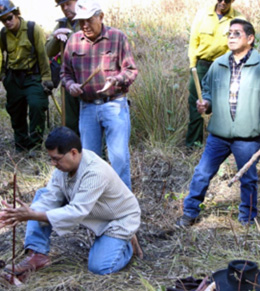This article is part of the Wildland Fire Learning In Depth series. It is designed for students who want to learn more about fire. Find the complete series on the Fire subject site.

Cultural Interpretations of Fire
Fire has been a benevolent, mystical, and religious symbol of great significance for cultures throughout the world.
Culture and History
The mythology of ancient Egypt contained a large, magnificently colored bird named the phoenix. According to the myth, the phoenix lived for up to 600 years. At the end of its life, the great creature built a funeral pyre (fire) and immolated (sacrificed) itself. From the funeral fire's ashes a new phoenix emerged with the freshness of youth to live out yet another cycle of life, death, and rebirth.
Other mythical stories from the hills of ancient Italy tell of the guardian priest, the king of the wood. He was regarded as the spirit of vegetation and was believed to be endowed with a magical power to make trees bear fruit. Although his life was held precious by his worshipers, the very value attached to it ensured his death. The ritual killing of the incarnate tree-spirit was believed to be the only way of preserving the spirit from inevitable decay. Each king of the wood had to be killed by fire so that the divine tree-spirit within him would be transferred in its entirety to a younger and more robust successor.
An analogy can be made between these recurring stories from classical antiquity and wildland fire management today. In a sense, naturally recurring wildland fires are analogous with a contemporary killing of the tree-spirit or the rebirth of the phoenix. Wildland fire, where properly prescribed and managed, fosters new plant growth and expands wildlife populations.
Forest Health
Fires remove dead trees and litter from the forest floor. Shrubs and trees invading grasslands also are killed by fires. In each example, new healthy regrowth occurs. Fire does not imply death, but rather change. As fire was associated with rebirth and renewal in mythology, fire today is recognized as an instrument of change and a catalyst for promoting biological diversity and healthy ecosystems.
People still often mistakenly consider all fires to be negative, destructive forces. However, when properly managed, fire can be an effective natural resource management tool.
Human Use of Fire
Fire has been used throughout history to shape the environment, improve hunting, and as an instrument of war. Today, fire is used regularly to benefit natural habitats and resources.
History
American Indians have great respect for the fire phenomenon—some named it “Grandfather Fire.” Historically, many American Indians used fire as a tool to shape their environment and improve areas for hunting. A century before European settlers arrived on North American shores on the Mayflower, the bison (or American buffalo), traditionally a western North American species, moved to the eastern portion of the continent following fires, many of which were probably set by American Indians. These fires burned the brush and trees and are believed to have helped in the creation of more open areas conducive to growth of grasslands, the lands upon which bison depend for food.
Fire was used by American Indians for hunting many different animals. Desert tribes removed ground cover with fire to facilitate lizard hunts. The Apaches used smoke to attract deer that were tormented by mosquitoes and flies. The deer would enter smoky areas to escape the bothersome insects and thus become easy targets for the hunters. European settlers observed American Indians using fire to herd deer onto peninsulas. Once in these small areas, deer could be hunted more easily from canoes.
More than improving hunting, fire was also used as an instrument of war. To protect from this, nomadic peoples burned the areas surrounding their lodges to thwart their enemies' attempts to burn them out. When hunting parties entered another tribe’s territory, some of the parties would deliberately set fires. This often would deprive the home tribe of forage that year but would make for better hunting in the following year when the interloping tribe returned.

NPS photo by Brent Johnson.
In California’s Yosemite Valley, American Indians used fire as a tool to shape the lands for at least 4,000 years. The cumulative effects of the thousand years of burning by American Indians had profound impacts on the landscape that European settlers found. When the first European colonists landed in the New World, they were amazed at how much savanna (or grassland) existed. As European settlers advanced across the continent, though, the frequency of fires declined. Consequently, woody vegetation and forests overtook some grassland corridors originally created by the fires set by American Indians.
Europeans held a view of fire and its effects that was very different from the American Indian view of the natural phenomena. At the close of the 19th century, settlers concentrated on permanent husbandry of the forests to protect watersheds and forest products. Crops also were of concern when wildfire control was discussed. As fences began to create a patchwork across the once open expanses of prairie and forest, fire became an enemy capable of destroying all that had been achieved.
Part of a series of articles titled Wildland Fire - Learning In Depth.
Previous: Wildland Fire Behavior
Last updated: January 2, 2017
